
Introduction:
Gingivitis:
Gingivitis (“inflammation of the gum tissue”) is a term used to describe non-destructive periodontal disease. The most common form of gingivitis is in response to plaque sticking to tooth surfaces and is the most common form of gum disease. In the absence of treatment, gingivitis may progress to periodontitis, which is a destructive form of gum disease.
While in some sites or individuals, gingivitis never progresses to periodontitis, research indicates that gingivitis always precedes periodontitis.
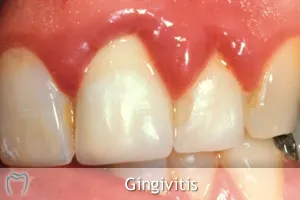
Signs and Symptoms:
The symptoms of gingivitis are somewhat non-specific and manifest in the gum tissue as classic signs of inflammation i.e:
- Swollen gums which bleed easily.
- Bright red or purple gums.
- Gums are tender and in some cases, painful to the touch.
Additionally, the ‘stippling’ that normally exists on the gum tissue of some people will often disappear and the gums may appear shiny when the gum becomes swollen and stretched over the inflamed underlying tissue. The accumulation may also create an unpleasant smell. When gums are swollen, the epithelial lining of the gingival crevice becomes ulcerated and the gums will bleed more easily even with gentle brushing, and especially when flossing.
Causes
The main cause of gingivitis is poor oral hygiene which leads to the accumulation of bacteria at the gum line; this is known as dental plaque. This in turn, can lead to destruction of the gingival tissues, which may progress to destruction of the periodontal attachment apparatus. The plaque builds up in the small gaps between teeth, in the gingival grooves and in areas known as ‘plaque traps’: locations that serve to accumulate and maintain plaque. Examples of plaque traps include bulky and overhanging margins of fillings, claps of removable dentures and tartar that forms on teeth. Although these accumulations may be tiny, the bacteria in them produce chemicals which create an inflammatory response in the gum tissue. This inflammation can cause an enlargement of the gingiva and lead to the symptoms described above.
Treatment
The aim of treatment for gingivitis is to remove the cause i.e. plaque. Treatment is aimed at the reduction of oral bacteria, and may take the form of regular trips to the dentist or dental hygienist together with adequate oral hygiene home care.
Treatment basically involves:
- Meticulous Oral Hygiene on a daily basis – thorough brushing and flossing.
- Use of mouthwashes
- Regular check-ups with the dentist or hygienist.
Periodontitis
The word “periodontitis” comes from peri (meaning “around”), odont (“tooth”) and -itis (“inflammation”). Periodontitis is a disease which affects the tissues that surround and support the teeth. Periodontitis involves progressive loss of the alveolar bone around the teeth, and if left untreated, can lead to the loosening and subsequent loss of teeth. Periodontitis is caused by microorganisms which stick to and grow on the tooth’s surfaces, along with an overly aggressive immune response against these microorganisms.
We diagnose periodontal disease by inspecting the soft gum tissues around the teeth with a special probe and by examining the patient’s x-ray(s); in diagnosing the disease, we want to determine the amount of bone loss around the teeth. Sometimes we will refer patients to a specialist dentist, known as a periodontist, for treatment of periodontitis.
The severity of disease refers to the amount of periodontal ligament fibres that have been lost, termed ‘Attachment Loss’.
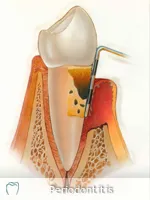
Classification
The standard classification of severity is as follows:
- Mild: 1–2 mm of attachment loss
- Moderate: 3–4 mm of attachment loss
- Severe: ≥ 5 mm of attachment loss
Signs and Symptoms
In the early stages, periodontitis has very few symptoms and in many people the disease has progressed significantly before they actually seek treatment. Symptoms may include the following:
- Redness or bleeding of gums while brushing teeth, using dental floss or biting into hard food
- Gum swelling that recurs
- Halitosis, or bad breath, and a persistent metallic taste in the mouth
- Gingival recession, resulting in apparent lengthening of teeth. (This may also be caused by heavy handed brushing or with a stiff tooth brush.)
- Deep pockets between the teeth and the gums (pockets are sites where the attachment has been gradually destroyed)
- Loose teeth, in the later stages (though this may occur for other reasons as well).
Patients should be aware that the gum inflammation and bone destruction are largely painless. Hence, people may wrongly assume that bleeding gums after toothbrushing is insignificant, although this may be a symptom of progressing periodontitis in that patient.
Causes
Periodontitis is an inflammation of the periodontium—the tissues that support the teeth. The periodontium consists of four tissues:
- Gingiva, or Gum Tissue
- Cementum, or outer layer of the roots of teeth
- Alveolar bone, or the bony sockets into which the teeth are anchored
- Periodontal Ligaments (PDLs), which are the connective tissue fibers that run between the cementum and the alveolar bone.
In some people, gingivitis may progress to periodontitis – with the destruction of the gingival fibres, the gum tissues separate from the tooth and form a deep crevice, called a periodontal pocket. Subgingival microorganisms (those that exist under the gum line) colonise the periodontal pockets and cause further inflammation in the gum tissues and progressive bone loss. Other examples of causes are those things that, by definition, cause microbic plaque accumulation, such as overhangs on fillings.
If left undisturbed, microbic plaque calcifies to form tartar. As dentists, we must completely remove this tartar above and below the gum line, in order to treat gingivitis and periodontitis. Although the main cause of both gingivitis and periodontitis is the microbic plaque that sticks to the tooth surface, there are many other modifying factors. A very strong risk factor is one’s genetic susceptibility. Several conditions and diseases, including Down syndrome, Diabetes, and other diseases that affect one’s resistance to infection also increase susceptibility to periodontitis.
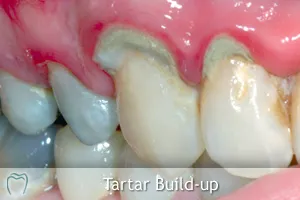
Prevention
Daily oral hygiene measures to prevent periodontal disease include:
- Brushing properly on a regular basis (at least twice daily), with the patient attempting to direct the toothbrush bristles underneath the gum-line, to help disrupt the bacterial growth and formation of subgingival plaque.
- Flossing daily and using interdental brushes (if there is enough space between the teeth), as well as cleaning behind the last tooth, the third molar, in each corner of the mouth.
- Using an antiseptic mouthwash. Chlorhexidine gluconate based mouthwash (e.g. Corsodyl) in combination with careful oral hygiene may cure gingivitis, although mouthwashing cannot reverse any attachment loss due to periodontitis.
- Using a ‘soft‘ toothbrush to prevent damage to tooth enamel and sensitive gums.
- Regular dental check-ups and professional teeth cleaning as required. Dental check-ups serve to monitor the person’s oral hygiene methods and levels of attachment around teeth, identify any early signs of periodontitis, and monitor response to treatment.
As dentists, we use special instruments to clean teeth below the gumline and disrupt any plaque growing below the gumline. This is a standard treatment to prevent any further progress of established periodontitis. Studies show that after such a professional cleaning (periodontal root debridement), microbic plaque tends to grow back to pre-cleaning levels after about 3–4 months. Hence, in theory, cleanings every 3–4 months might be expected to also prevent the initial onset of periodontitis. However, analysis of published research has reported little evidence either to support this or the intervals at which this should occur. Instead, it is advocated that the interval between dental check-ups should be determined specifically for each patient between every 3 to 24 months.
Nonetheless, the continued stabilization of a patient’s periodontal state depends largely, if not primarily, on the patient’s oral hygiene at home as well as on the go. Without daily oral hygiene, periodontal disease will not be overcome, especially if the patient has a history of extensive periodontal disease.
Management
The cornerstone of successful periodontal treatment starts with excellent oral hygiene. This includes twice daily brushing with daily flossing. Also the use of an interdental brush is helpful if space between the teeth allows. People with dexterity problems such as arthritis may find oral hygiene difficult and may require more frequent professional care and/or the use of a powered tooth brush. Persons with periodontitis must realise that it is a chronic inflammatory disease and a lifelong regimen of excellent hygiene and professional maintenance care with a dentist/hygienist/periodontist is required to maintain affected teeth.
Initial therapy
Removal of plaque and tartar is necessary to establish periodontal health. The first step in the treatment of periodontitis involves non-surgical cleaning below the gumline with a procedure called scaling and debridement. In the past, Root Planing was used (removal of cemental layer as well as calculus). This procedure involves use of special instruments to mechanically remove plaque and tartar from below the gumline, and may require multiple visits and local anesthesia to adequately complete. In addition to initial scaling and root planing, it may also be necessary to adjust the bite to prevent excessive force on teeth that have reduced bone support. It may also be necessary to complete any other dental needs such as replacement of rough, plaque retentive fillings, closure of open contacts between teeth, and any other requirements diagnosed at the initial evaluation.
Re-evaluation
Multiple clinical studies have shown that non-surgical scaling and root planing is usually successful if the periodontal pockets are shallower than 4–5 mm. It is necessary for us to perform a re-evaluation 4–6 weeks after the initial scaling and root planing, to determine if the treatment was successful in reducing pocket depths and eliminating inflammation. Pocket depths which remain after initial therapy of greater than 5-6mm with bleeding upon probing are indicate continued active disease and will very likely show further bone loss over time. This is especially true in molar tooth sites where areas between the roots have been exposed.
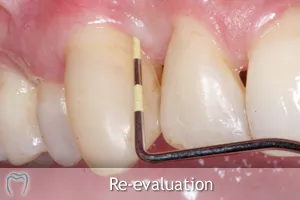
Surgery
If non-surgical therapy is found to have been unsuccessful in managing signs of disease activity, periodontal surgery may be needed to stop progressive bone loss and regenerate lost bone where possible. There are many surgical approaches used in treatment of advanced periodontitis, including open flap debridement, osseous surgery, as well as guided tissue regeneration and bone grafting. The goal of periodontal surgery is access for definitive calculus removal and surgical management of bony irregularities which have resulted from the disease process to reduce pockets as much as possible. Long-term studies have shown that in moderate to advanced periodontitis, surgically treated cases often have less further breakdown over time and when coupled with a regular post-treatment maintenance regimen are successful in nearly halting tooth loss in nearly 4 out of 5 patients
Maintenance
Once successful periodontal treatment has been completed, with or without surgery, an ongoing regimen of “periodontal maintenance” is required. This involves regular checkups and detailed cleanings every three months to prevent re-population of periodontitis-causing microorganism, and to closely monitor affected teeth so that early treatment can be provided if disease recurs. As we mentioned above, usually periodontal disease exists due to poor plaque control, therefore if the brushing techniques are not modified, a periodontal recurrence is likely.
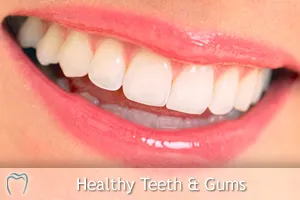
Alternative Treatments
Periodontitis has an inescapable relationship with subgingival tartar. The first step in any procedure is to eliminate calculus under the gum line, as it houses destructive microorganisms that consume bone, gum and cementum for food.
Most alternative “at-home” gum disease treatments involve injecting anti-microbial solutions, such as hydrogen peroxide, into periodontal pockets via slender applicators or oral irrigators. This process disrupts anaerobic microorganism colonies and is effective at reducing infections and inflammation when used daily. A number of potions that are functionally equivalent to hydrogen peroxide are commercially available but at substantially higher cost. However, such treatments do not address tartar build-up, and so are short-lived, as anaerobic microorganism colonies quickly regenerate in and around tartar.






